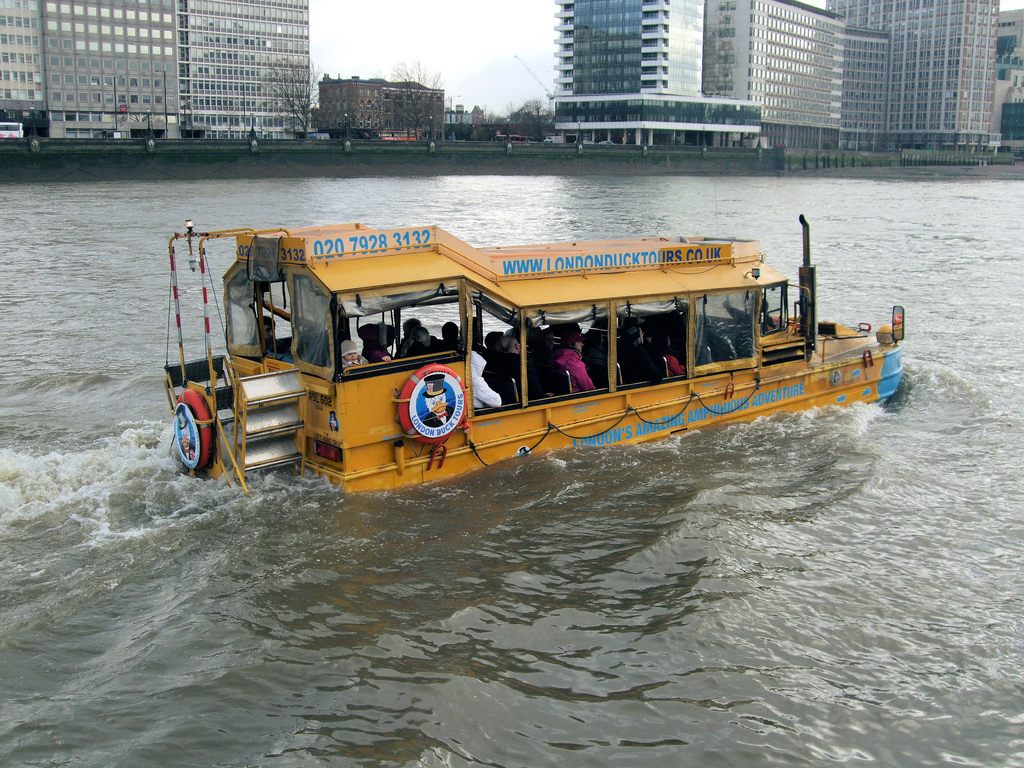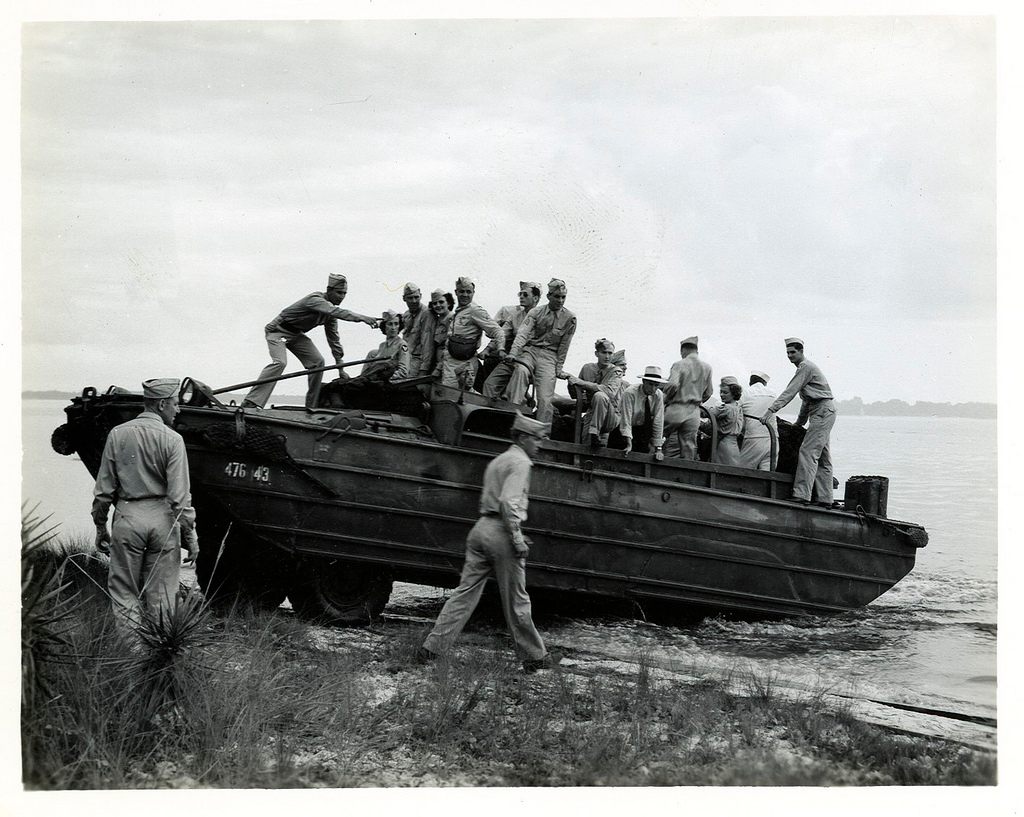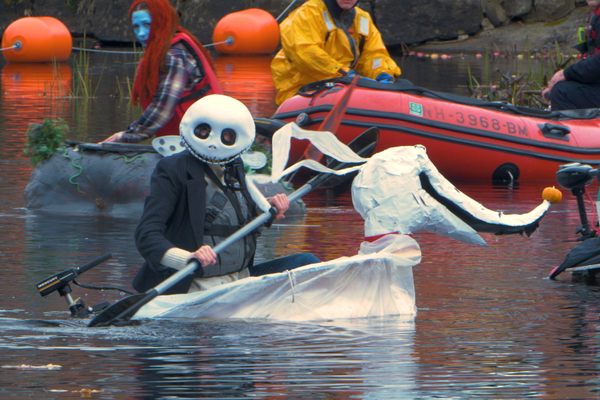Can a Duck Boat Cross the Atlantic?

A London Duck tour boat on the Thames. (Photo: Jim Linwood/flickr)
For years I’ve had this dream. This is how it would go: We’d depart from Plymouth, MA, then sail northeast toward Greenland, traversing open seas for about 4,000 miles. Soon we’d approach the Greenland Sea’s mouth and up ahead at the head of our machine would materialize the coast of Iceland. I’d put my arm on my first mate. “Look out yonder, ” I’d say. “We made the journey. We did it.”
On a duck boat.

This dream, in fact, is not unique. A few years back, a man by the name of Richard Coe announced his intention to set sail from London with an Australia destination using only a duck boat. These hybrid truck-boat vehicles—which were once official army vehicles and are now staples for local tourist traps—date back more than 60 years ago and look like floating semi-truck trailers with fewer wheels.
But it turns out that saying you want to commence a transatlantic duck boat voyage is easier said than done. Not only is it difficult to find these amphibious vehicles, there are obvious pitfalls due to duck boats’ now-ancient architecture. So is it actually possible to retrofit one of these vessels into a modern-day Royal Caribbean? I decided to investigate and see if it were truly possible to sail these behemoths long distance.

A 160 DUKW at Tyndall Field, Florida, c 1942. (Photo: Richard/flickr)
Duck boats, officially dubbed DUKW boats, were first seen in 1942, having been built by General Motors for the U.S. government to be used as hybrid land-sea vehicles. A little over ten years later the government discontinued DUKW use and they have now become common kitschy transportation for local tour companies.
According to Matt Oetger, an assistant manager at the Original Wisconsin Duck tour company in the Wisconsin Dells, DUKWs were used for amphibious landings in places like the South Pacific. The US built around 21,000 machines—more than 2,000 DUKWs were used in the invasion at Normandy.
DUKWs are eight feet high, 31 feet across. They have six wheels, weigh over 13,000 pounds, and can hold as many as 21 people. They were meant to be ferry vehicles between larger ships and land. Oftentimes they would carry artillery to war zones or carry wounded soldiers out of harm’s way onto a medic’s boat. DUKW’s only important task was getting from water onto land and vice versa.
While their design is well known, it’s actually rare to see a true original DUKW in the wild. The Wisconsin Ducks is one of a few companies that still use them. Most others tour companies have newly-built devices that have DUKW-like exteriors. These modern vehicles have bigger chassis to accommodate more people, higher walls, and stronger motors.
Atlanta-based Ride The Ducks is one of the leaders in the modern amphibious vehicle space. Their machines, which use Ride The Ducks’ own patented designs, have “entirely new hulls, thoroughly modern gear, ABS brakes,” explained president Chris Herschend. “The only tie to the World War II DUKWs is the profile.”
 Rear view of a DUKW at Fort Lewis Military Museum, Fort Lewis, Washington, USA. (Photo: Joe Mabel/WikiCommons CC BY-SA 3.0)
Rear view of a DUKW at Fort Lewis Military Museum, Fort Lewis, Washington, USA. (Photo: Joe Mabel/WikiCommons CC BY-SA 3.0)
Safety concerns have led this move toward modernized amphibious trucks. For example, for a commercial vehicle to ride in Coast Guard protected water it must get the agency’s approval — which the DUKWs will likely not get. More, in 1999 when a DUKW tour boat sank in Hot Springs, Arkansas killing 11 people. This was widely considered an industry wakeup call.
Given all this, Herschend wasn’t so enthusiastic about my idea of sailing a DUKW long distance. “They’re divas,” he said “Difficult to maintain, part supply is difficult to come by.” Also, they’re slow. A naval architect once told Ride The Ducks that moving such large machines was like “pushing a refrigerator through the water.” Even Herschend’s boats would go at a snail’s pace in the Atlantic.
An amphibious vehicle tinkerer named John Giljam offered similar thoughts. Giljam was described as the “mad scientist in the industry.” His website is filled with cool-looking ovular-shaped beasts on wheels that reportedly don’t sink.
 A DUKW amphibious truck on land. (Photo: Public Domain/WikiCommons)
A DUKW amphibious truck on land. (Photo: Public Domain/WikiCommons)
Giljam is quick to distinguish his amphibious rigs from DUKWs. His machines have longer hulls to handle large waves and are built out of aluminum to be lighter. “Ours has floatation foam so they don’t sink,” he says. The only thing that his vessels and DUKWs have in common is “the name ‘amphibious.’”
A DUKW’s freeboard — which is the length of a ship’s side from the water to the deck — can be as low as 12 inches. “You don’t want to go into a hurricane or something like that,” he said. Not only that, but (as Herschend mentioned prior) they’re slow. DUKWs go about four knots, said Giljam, which is less than five miles/hour. He just didn’t see how such a DUKW transformation could happen. As for his own vessels, “I wouldn’t think twice about taking one from Florida to the Bahamas.”
 A Boston Duck tour vehicle. (Photo: Rawhead/WikiCommons CC BY-SA-2.5)
A Boston Duck tour vehicle. (Photo: Rawhead/WikiCommons CC BY-SA-2.5)
With all this, there was one last person who might be able to prove these experts wrong. Richard Coe, the UK-based researcher, had announced his plans to sail a DUKW boat from London to Australia about two years ago. He spent 2014 traveling around the globe seeking out sponsors that would be will to pay over the $100,000 to acquire bonafide DUKW and make the necessary modifications. One article said he planned to set sail in 2015.
I sent him a message early on and heard nothing for a week. Perhaps he was already aboard his newly-fashioned DUKW somewhere south of France. Then after a week he got back to me.
“As it stands, my plans have changed in that I won’t be using a DUKW for my expedition,” he wrote. “These have proved far too difficult to source … They were amazing vehicles at the time of their production but were ultimately designed for relatively short haul service.” Coe added that he found sponsorship for the trip, but will now use a modernized amphibious vehicle.
And with this message, my fears were realized. A dream deferred.














Follow us on Twitter to get the latest on the world's hidden wonders.
Like us on Facebook to get the latest on the world's hidden wonders.
Follow us on Twitter Like us on Facebook